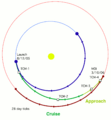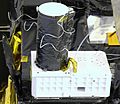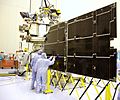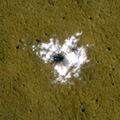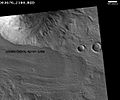Mars Reconnaissance Orbiter facts for kids
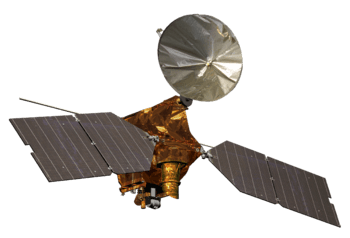
Artist's impression of the Mars Reconnaissance Orbiter spacecraft.
|
|
| Mission type | Mars orbiter |
|---|---|
| Operator | NASA / JPL |
| Website | |
| Mission duration | Primary mission: 2 years Elapsed: 19 years, 8 months and 3 days from launch 19 years, 1 month and 5 days (6789 sols) at Mars |
| Spacecraft properties | |
| Manufacturer | Lockheed Martin / University of Arizona / APL / ASI / Malin Space Science Systems |
| Launch mass | 2,180 kg (4,810 lb) |
| Dry mass | 1,031 kg (2,273 lb) |
| Payload mass | 139 kg (306 lb) |
| Power | 2,000.0 watts |
| Start of mission | |
| Launch date | August 12, 2005, 11:43:00 UTC |
| Rocket | Atlas V 401 |
| Launch site | Cape Canaveral SLC-41 |
| Contractor | ILS |
| Orbital parameters | |
| Reference system | Areocentric |
| Regime | Sun-synchronous |
| Inclination | 93 degrees |
| Mars orbiter | |
| Orbital insertion | March 10, 2006, 21:24:00 UTC MSD 46990 12:48 AMT 20 Dhanus 211 Darian |
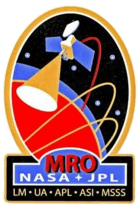 Official insignia of the Mars Reconnaissance Orbiter mission. |
|
Mars Reconnaissance Orbiter is a NASA spacecraft. It launched August 12, 2005 from Cape Canaveral, Florida, and arrived at Mars on March 10, 2006. It went into orbit around Mars, and has been studying the planet since then. The main area of study is looking for water on Mars, under the surface of Mars, and in the atmosphere of Mars. To do this, it has the largest telescope ever sent to another planet. The orbiter also works as a communications satellite. Its powerful antennas send and receive messages between NASA on Earth, and rovers on the surface of Mars.
Images for kids
-
Launch of Atlas V carrying the Mars Reconnaissance Orbiter, 11:43:00 UTC August 12, 2005
-
Image of Phoenix landing on Mars, as seen by HiRISE. Although in the image it appears to be descending into the crater, Phoenix actually landed 20 km (12 mi) away from it.
-
The Phoenix lander and its heatshield as seen by HiRISE
-
Tracks of the rover Opportunity, as seen by HiRISE. The white dots are places where the rover stopped to perform scientific observations or turned.
-
The Curiosity rover during atmospheric entry as seen by HiRISE on August 6, 2012. Supersonic parachute and backshell visible.
-
Perseverance rover parachute descend over the Jezero crater photographed by HiRISE on February 18, 2021.
See also
 In Spanish: Mars Reconnaissance Orbiter para niños
In Spanish: Mars Reconnaissance Orbiter para niños



